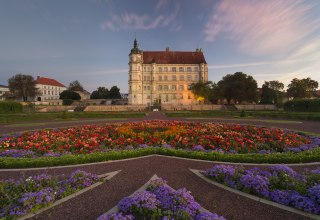Ernst Barlach (1870-1938) was not only a draftsman, graphic artist and writer, but also one of the most important sculptors of German Expressionism. In his studio house and the Gertruden Chapel, the Ernst Barlach Museums Güstrow present the world's largest contiguous collection of works by the internationally renowned artist.
In the midst of the Heidberge, directly on the shore of the Güstrow island lake, lived and worked one of the most important German sculptors, graphic artists and writers of the 20th century: Ernst Barlach.
The expressionist artist had moved to the small town in Mecklenburg in 1910 and created most of his multifaceted work here. At the center of his work was always the human being with his emotions, worries and hardships, for which Barlach found a timeless formal language reduced to the essential.
Important artistic successes in the 1920s were followed by hostility as a degenerate artist, which Barlach resisted in the form of his Wanderer in the Wind. Nevertheless, he had to experience the successive repression of his art from the public sphere until his death in 1938.
With the end of the Nazi era, Barlach's art experienced a rehabilitation that made him - along with Wilhelm Lehmbruck (1881-1919) and Georg Kolbe (1877-1947) - one of the most important, internationally esteemed sculptors of the first half of the 20th century.
The Ernst Barlach Museums in Güstrow preserve the world's largest estate of the artist with works from all creative periods. As early as 1953, the first Barlach memorial was opened in the Gertruden Chapel. To this day, the Gothic chapel houses some 30 sculptural works by Ernst Barlach, including Reading Monastery Student, The Bound Witch, The Doubter and Woman in the Wind. In the nearby Güstrow Cathedral, the world-famous World War I memorial, The Hovering Man by Ernst Barlach, can be seen.
The Atelierhaus am Heidberg, built in 1930/31, has been open to visitors since 1978 and, in addition to works such as Singender Mann (Singing Man), Der Träumer (The Dreamer) and the designs for Barlach's numerous memorials, presents an insight into the life and work of the artist. With the establishment of the Ernst Barlach Foundation in 1994, the foundation stone was laid to preserve Ernst Barlach's diverse œuvre at its authentic place of work and to present it to the public.
With top-class special exhibitions, concerts, readings and creative workshops, the Ernst Barlach Museums Güstrow invite visitors to a lively dialogue with Barlach's art. Individual offers for school classes, private family celebrations, hen parties or corporate events round off the range of events.





















